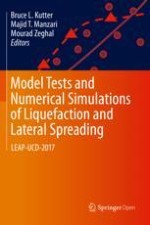Open Access 2020 | Open Access | Buch

Model Tests and Numerical Simulations of Liquefaction and Lateral Spreading
LEAP-UCD-2017
herausgegeben von: Bruce L. Kutter, Dr. Majid T. Manzari, Mourad Zeghal
Open Access 2020 | Open Access | Buch

herausgegeben von: Bruce L. Kutter, Dr. Majid T. Manzari, Mourad Zeghal
This open access book presents work collected through the Liquefaction Experiments and Analysis Projects (LEAP) in 2017. It addresses the repeatability, variability, and sensitivity of lateral spreading observed in twenty-four centrifuge model tests on mildly sloping liquefiable sand. The centrifuge tests were conducted at nine different centrifuge facilities around the world. For the first time, a sufficient number of experiments were conducted to enable assessment of variability of centrifuge test results. The experimental data provided a unique basis for assessing the capabilities of twelve different simulation platforms for numerical simulation of soil liquefaction. The results of the experiments and the numerical simulations are presented and discussed in papers submitted by the project participants.
The work presented in this book was followed by LEAP-Asia that included assessment of a generalized scaling law and culminated in a workshop in Osaka, Japan in March 2019. LEAP-2020, ongoing at the time of printing, is addressing the validation of soil-structure interaction analyses of retaining walls involving a liquefiable soil. A workshop is planned at RPI, USA in 2020.